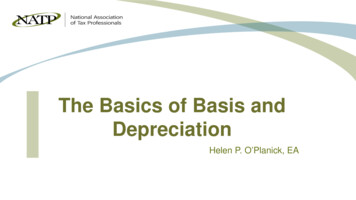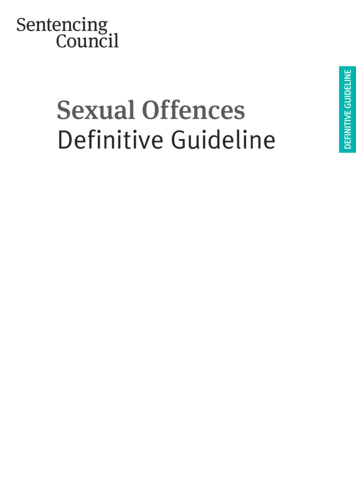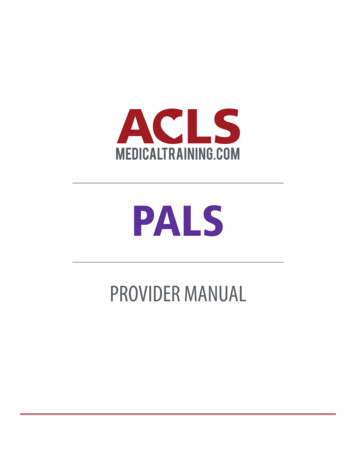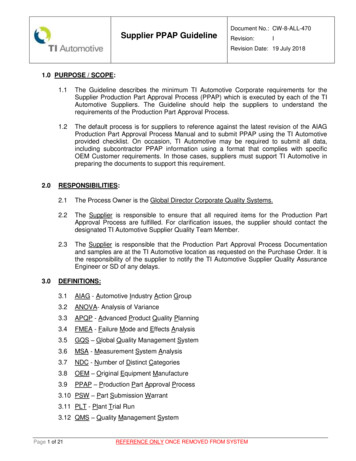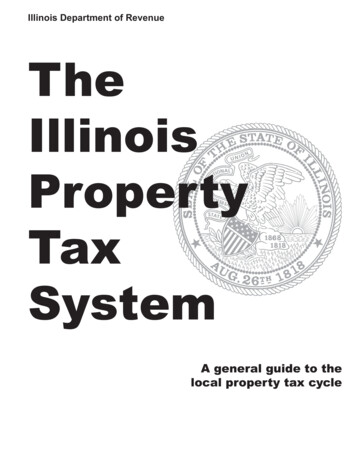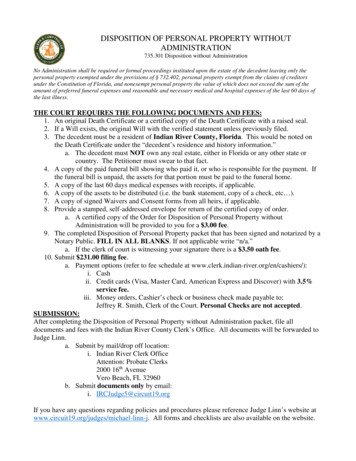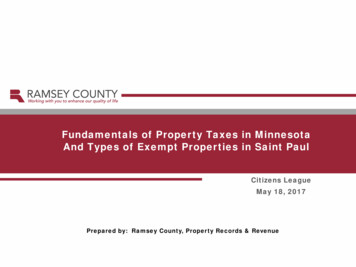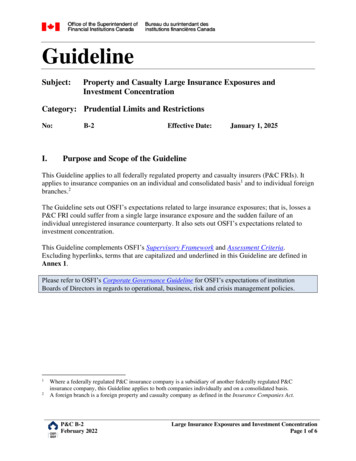
Transcription
GuidelineSubject:Property and Casualty Large Insurance Exposures andInvestment ConcentrationCategory: Prudential Limits and RestrictionsNo:I.B-2Effective Date:January 1, 2025Purpose and Scope of the GuidelineThis Guideline applies to all federally regulated property and casualty insurers (P&C FRIs). Itapplies to insurance companies on an individual and consolidated basis1 and to individual foreignbranches.2The Guideline sets out OSFI’s expectations related to large insurance exposures; that is, losses aP&C FRI could suffer from a single large insurance exposure and the sudden failure of anindividual unregistered insurance counterparty. It also sets out OSFI’s expectations related toinvestment concentration.This Guideline complements OSFI’s Supervisory Framework and Assessment Criteria.Excluding hyperlinks, terms that are capitalized and underlined in this Guideline are defined inAnnex 1.Please refer to OSFI’s Corporate Governance Guideline for OSFI’s expectations of institutionBoards of Directors in regards to operational, business, risk and crisis management policies.12Where a federally regulated P&C insurance company is a subsidiary of another federally regulated P&Cinsurance company, this Guideline applies to both companies individually and on a consolidated basis.A foreign branch is a foreign property and casualty company as defined in the Insurance Companies Act.P&C B-2February 2022Large Insurance Exposures and Investment ConcentrationPage 1 of 6
II.Large Insurance ExposuresGross Underwriting Limit PolicyP&C FRIs should have a comprehensive Gross Underwriting Limit Policy (GUWP)3 that isconsistent with the P&C FRI’s Risk Appetite Framework.41. The GUWP should:a. Define what constitutes a Single Insurance Exposure by class of insurance, asappropriate. A P&C FRI could aggregate insurance exposures across multiplecoverages and/or classes of insurance;b. Establish limits by class of insurance regarding the level of gross insurance risk thatthe P&C FRI is willing to accept in respect of a maximum loss related to a SingleInsurance Exposure; andc. Be reviewed by Senior Management of the P&C FRI, at a minimum, annually.2. Using relevant, reasonable and supportable information, P&C FRIs should measure anddetermine the maximum loss on a Single Insurance Exposure. They should make such adetermination without regard to the probability of the loss event occurring, and usingapproaches that are risked-based and forward-looking (i.e., not solely based on past losses).3. With respect to the certain classes of insurance set out below, P&C FRIs should consider thefollowing in respect of determining a Single Insurance Exposure:PropertyThe aggregated insurance exposures on in-force policies at a single location,including any exposures subject to the location.CreditThe aggregated insurance exposures on in-force policies to any one singlebuyer or group of connected buyers.SuretyThe aggregated insurance exposures on in-force bonds to any one singlecontractor or group of connected contractors.TitleThe aggregated insurance exposures on in-force policies related to the legaltitle for a single location.4. P&C FRIs should have adequate systems to identify and actively manage insuranceexposures.5. P&C FRIs should have effective monitoring and internal reporting procedures to ensureongoing operational compliance with the GUWP.34The GUWP can be one consolidated document or a set of policy documents.The requirements for the Risk Appetite Framework are outlined in OSFI’s Corporate Governance Guideline.P&C B-2February 2022Large Insurance Exposures and Investment ConcentrationPage 2 of 6
OSFI expects FRIs to develop and establish their own criteria and approach for determiningand measuring the maximum loss on a Single Insurance Exposure.6. P&C FRIs are expected to provide, at OSFI’s request, all information with respect to theirlarge Single Insurance Exposures. OSFI may, at its discretion, advise a P&C FRI to usespecific criteria or an approach to determine and measure its maximum loss on a SingleInsurance Exposure.Insurance Exposure Limit7. This section applies to the direct business of P&C FRIs. It also applies to a P&C FRI’sassumed business from an Affiliated Company, where that Affiliated Company is a P&C FRIand is a direct writer of that business.8. At no time should any P&C FRI’s Net Retention, plus its Largest Net CounterpartyUnregistered Reinsurance Exposure, due to the occurrence of a maximum loss on a SingleInsurance Exposure, exceed the following limits:Insurance Companiesi.ii.Foreign Branches100 per cent of Total Capital Available where anyentity in the P&C FRI’s control chain is:a. a widely held company5, and/orb. a regulated financial institution;25 per cent of Total Capital Available otherwise.100 per cent of Net Assets Available of the foreign branch.9. With respect to the Largest Net Counterparty Unregistered Reinsurance Exposure, P&C FRIsshould measure their ceded unregistered reinsurance exposures to a given counterparty, orgroup of Affiliated Company counterparties, on both a gross and a net basis. That is, itshould be measured before and after the recognition of any eligible Counterparty RiskMitigation (CRM) technique. Only the aggregate net counterparty exposures for unregisteredreinsurance are subject to the limits in Paragraph 8 above.10. Eligible CRM techniques may include, as applicable:a. Excess collateral;b. Letters of Credit6;c. Other CRM techniques deemed acceptable by OSFI.7567with shares that are publicly traded on a recognized stock exchange.The limit on the use of letters of credit for unregistered reinsurance with a given counterparty, or group ofAffiliated Company counterparties, including any letters of credit that are part of excess collateral, is 30% and ismeasured against the value of the insurance exposure.A P&C FRI may reduce its required Net Counterparty Unregistered Reinsurance Exposure if the CRMtechniques meet the requirements of Guideline A “Minimum Capital Test” and Guideline B-3 “SoundReinsurance Practices and Procedures”.P&C B-2February 2022Large Insurance Exposures and Investment ConcentrationPage 3 of 6
III.Investment ConcentrationP&C FRIs should have policies with respect to the management of investment concentration,which include internal limits. The policies should be consistent with the P&C FRIs’ RiskAppetite Framework.11. A P&C FRI’s aggregate market value of Investments in any one Entity or group of AffiliatedCompanies should not exceed the following limit:Insurance CompaniesForeign Branches5 per cent of the company's Assets5 per cent of the company's Assets in Canada12. P&C FRIs should consider other Investments or commitments not shown on the balancesheet; for example, options, futures, forward contracts and unfunded portions of committedloans.IV.Guideline Administration13. Where a P&C FRI is in non-compliance of this Guideline, OSFI may, on a case-by-casebasis, take or require the P&C FRI to take corrective measures. OSFI measures may include,but would not be limited to, heightened supervisory activity and/or the discretionaryauthority to adjust the P&C FRI’s capital requirements commensurate with the risks beingundertaken by the P&C FRI.-END-P&C B-2February 2022Large Insurance Exposures and Investment ConcentrationPage 4 of 6
Annex 1 – DefinitionsSingle Insurance Exposure14. P&C FRIs can define what constitutes a Single Insurance Exposure within their GUWP.Affiliated Companies15. One entity is affiliated with another entity if one of them is controlled by the other or both arecontrolled by the same person or entity.Net Retention16. The amount of insurance exposure which a P&C FRI retains net for its own account and doesnot pass on to another insurer (or reinsurer)8. Any reinstatement premiums should beincluded in the Net Retention value.Largest Net Counterparty Unregistered Reinsurance Exposure17. The largest amount of ceded unregistered reinsurance on an insurance exposure provided bya (re)insurance group (e.g., Affiliated Company counterparties that are part of a (re)insurancegroup). This amount should be on a net basis; that is, after recognition of any eligible CRMtechnique.Total Capital Available18. For a P&C FRI that is a company, the consolidated total available capital of a company asdefined for the purpose of calculating the Minimum Capital Test (MCT) / Mortgage InsurerCapital Adequacy Test (MICAT).Net Assets Available19. For a P&C FRI that is a foreign branch, the net assets available as defined for the purposes ofcalculating the Branch Adequacy of Assets Test (BAAT).Investments20. An asset or item acquired with the goal of generating income or appreciation, excludingloans to, and loans guaranteed or securities issued or guaranteed by the Government ofCanada, a Canadian province or a member jurisdiction of the Organisation for Economic Cooperation and Development (OECD).8A P&C FRI may reduce its required capital (or “assets” in the case of foreign branches) for ceded reinsurance ifit meets the requirements of Guideline B-3 “Sound Reinsurance Practices and Procedures”.P&C B-2February 2022Large Insurance Exposures and Investment ConcentrationPage 5 of 6
Entity21. As defined in the Insurance Companies Act, a natural person, a body corporate, trust,partnership, fund, unincorporated association or organization, an agency of the Crown inright of Canada or of a province, and any agency of a foreign government.Assets22. For a P&C FRI that is a company, the total value of assets reported on the balance sheet ofthe regulatory return filed with OSFI.Assets in Canada23. For a P&C FRI that is a foreign branch, the total value of assets under the control of theMinister (vested in trust in Canada), as reported on the balance sheet of the regulatory returnfiled with OSFI.P&C B-2February 2022Large Insurance Exposures and Investment ConcentrationPage 6 of 6
Foreign Branches 100 per cent of Net Assets Available of the foreign branch. 9. With respect to the Largest Net Counterparty Unregistered Reinsurance Exposure, P&C FRIs should measure their ceded unregistered reinsurance exposures to a given counterparty, or group of Affiliated Company counterparties, on both a gross and a net basis. That is, it



